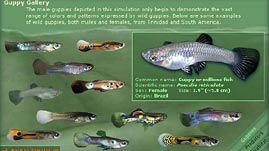Teachers' Domain - Digital Media for the Classroom and Professional Development
User: Preview


Source: Evolution Web site
Mating in the wild can be dangerous business, especially when the bright colors, big tails, and flashy patterns some animals use to attract potential mates can also attract predators. In this Evolution feature, based on a famous experiment by John Endler, users create virtual streams and stock them with bright to drab male guppies and up to three different predators. With each simulation, the guppy population changes due to selection pressure from both predators and mates.
When evolutionary biologist John Endler began studying Trinidad's wild guppies in the 1970s, he was struck by the wide variation among guppies from different streams, even among guppies living in different parts of the same stream. Males from one pool sported vivid blue and orange splotches along their sides, while those farther downstream carried only modest dots of color near their tails. Endler also observed differences in the distribution of guppy predators, and in the color and size of the gravel in different stream locations.
Endler photographed hundreds of guppies and carefully recorded their size, color, and the size and placement of their spots. He began to see a strong correlation between where guppies lived in a particular stream and whether the fish were bright or drab. But what was responsible for these trends in coloration? And if bright colors made guppies more conspicuous to predators, why should males be colorful at all? Endler formed a hypothesis based on his observations, then set out to test it. His results would prove to be one of evolutionary biology's most important discoveries.
 Loading Standards
Loading Standards Teachers' Domain is proud to be a Pathways portal to the National Science Digital Library.
Teachers' Domain is proud to be a Pathways portal to the National Science Digital Library.
